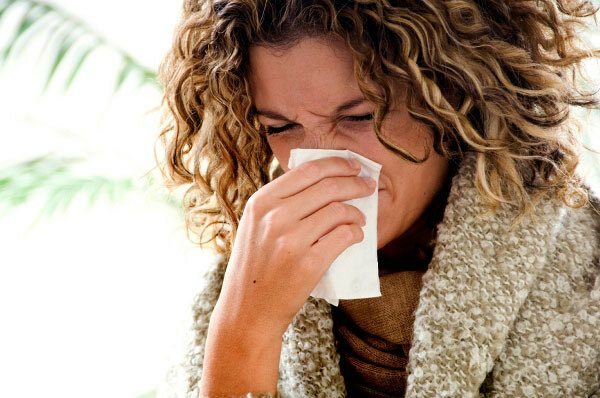
Contents of the page
- 1 Allergy to wool - what is dangerous and what is it?
- 2 Interesting facts:
- 3 What is the nature of the problem - the causes of the disease
- 4 Natural protection
- 5 Stages of development of animal allergy
- 6 Symptomatic - how to detect an allergy in animals:
- 7 Diagnosis of the disease
- 8 How to defeat allergy - treatment methods
- 9What to do with a pet if there is an allergy?
- 10 Prevention and measures to reduce the occurrence of allergy:
According to statistics, more than 20% of the total population of the country is susceptible to such a disease as an allergy to animals. This turns the content of pets into a real nightmare, and communication with our lesser brothers from the positive emotions turns into torture. Allergies are a common ailment, both among children and adults. Let's consider the reasons of occurrence, features of course of an illness and methods of struggle against it.
Allergy to wool - what is dangerous and what is it?
Hair allergy is a pathological condition that is characterized by an increased intensity of the body in response to a certain substance that is not a threat. Today, the manifestation of allergic reactions tends to increase, as unfavorable factors influence the person: environmental contamination, poor nutrition, stress, etc. Scientists say that by the year 2015 every seventh citizen will have at least one allergic disease.
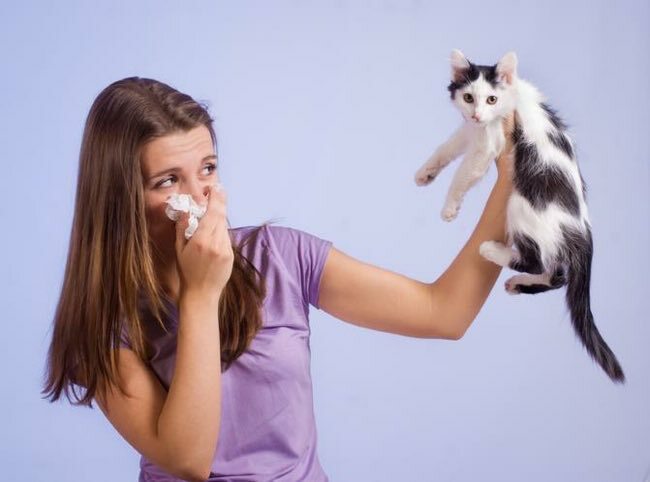
Allergy to pets in children is one of the most common types of ailment. At the same time for allergies is not peculiar seasonality and periods of fading reactions. The disease can occur at any age, it represents the same threat, both for adults and for children. There are cases when the allergy was inherited, and the child already had a predisposition to ailment.
Allergies cause a number of unpleasant symptoms in a person that interfere with normal life activity. Therefore, if they are found, medical measures should be taken. Similarly, the disease can cause a number of complications, which can lead up to a lethal outcome.
Interesting facts:
-
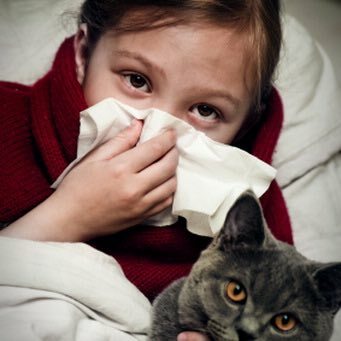 wool is not the only provoking allergic reaction. To lead to a sharp deterioration of the human condition can feces, urine, saliva of animals;
wool is not the only provoking allergic reaction. To lead to a sharp deterioration of the human condition can feces, urine, saliva of animals; - heat treatment does not help get rid of the allergen. For example, the boiled clothes on which the wool has remained will continue to cause a reaction;
- allergy contributes to the weakening of immunity;
- patients who have high blood pressure are at increased risk of developing the disease.
The possibility of allergy damage is much higher if a person has viral and somatic diseases, as well as suffering from diseases of the digestive system. Other risk factors include the following:
- weakening of sectoral immunity;
- increased sensitivity of tissues to irritant;
- congenital malformations in the processes of deactivation of the allergen;
- inflammation of the intestinal mucosa;
- infection with parasites;
- prolonged use of antibiotics;
- hereditary predisposition.
What is the problem - the causes of the disease
Hair allergy is not a natural reaction of the body, despite the fact that it proceeds as a defensive action when exposed to a hazardous substance. The cause of this reaction is the allergen, which causes the immune system to work against itself. The organism seeks to destroy the allergen, traumatizing its own cells and tissues. The main allergens are the following:
- wool - an irritant is carotene, which in different animal species has a different structure. Therefore, in most cases a person is allergic only to a certain type of pet - only dogs or only cats, for example;
- saliva - differs from human much more enzymes, because animals have to deal with rough food. The increased content of amylase and protein makes saliva concentrated and dangerous in terms of causing an allergic reaction;
- skin flakes are the most dangerous allergen that is invisible to the human eye, so it is extremely difficult to combat it. Skin parts are peeled off from animals, crushed, becoming like dust. During the activities of pets, this dust spreads and settles on furniture, interior items, clothes, causing deterioration in the person's well-being;
- urine is different from human acidity, so if it gets on the skin it can cause irritation of the epidermis and decrease its protective function. Particles of urine can be spread over a fur coat to a pet during its "washing", and then cause a person to have an allergy on contact;
- feces - contain an elevated level of immunoglobulin. Particles of feces can stay on the animal's tray for a long time, then be carried to the air and settle on the objects of the room.

Natural protection
It was previously believed that allergy to animals is a pathology, and the body does not have protection from the occurrence of a reaction. To develop the disease, it is necessary to get the allergen into the lymph or blood. However, before this happens, the allergen must undergo natural body protection:
- saliva - maltase, which is in the saliva, splits carbohydrates and can destroy allergen compounds, preventing its effect on the body;
- gastric juice - an aggressive environment that allows to destroy the irritating factor;
- bile - breaks down the incoming substances into smaller ones, allows to break down fats, as the allergen breaks up into particles, it loses its ability to influence the body;
- intestinal microflora - ensures the balance of the immune system, so that the likelihood of allergies is minimized;
- epidermis is a protective function that protects a person from direct contact with an allergen. Similarly, the epidermis removes harmful products of vital activity and cleanses the body;
- sweat and sebaceous glands - form on the skin a thin impermeable film, which serves as an additional factor of protection.
Stages of development of allergy to animal wool
The stage of immune reactions is the first stage of the disease. The organs of the immune system provide protection for the whole organism, absorbing the allergen. After the destruction of the foreign agent, the cells absorb some of the allergen molecules, creating an antigen. With the help of blood circulation, cells carry information about the allergen throughout the body. Upon repeated contact with the agent, all other cells and organs are already "notified" of the threat and begin to immediately eliminate it.
Stage of biochemical reaction - with repeated contact with the allergen, lymphocytes begin to "flock" to the site of the threat, due to the expansion of blood vessels in the contact zone with the allergen. The more lymphocytes arrive at the site of contact, the more vivid the allergic reaction will be.

Stage of clinical manifestations - allergy to animals is characterized by the defeat of the respiratory system, less often - digestion. Symptoms can affect the epidermis, causing irritation and redness. The rate of reaction to an allergen depends on individual characteristics. There are several types of reaction rates, the average is about an hour and a half after contact.
Symptomatic - how to identify allergies in animals:
-
 nasal congestion - the most common symptom of disease, occurs in three of four patients. There is swelling of the mucosa and shortness of breath;
nasal congestion - the most common symptom of disease, occurs in three of four patients. There is swelling of the mucosa and shortness of breath; - cough - inflammatory reaction and swelling of the mucosa of the respiratory tract. There may be a dry or wet cough;
- hoarseness of voice - a violation of the shape of the vocal cords, which affects the frequency of vibration of the voice;
- stuffiness of the ears - inflammation of the Eustachian tubes, which entails pressure changes in the inner ear;
- shortness of breath - there may be different kinds of shortness of breath, which are characterized by edema of the upper respiratory tract with the involvement of palatine almonds. Shortness of breath is a symptom of allergy when a patient has bronchial asthma;
- cyanosis - blueing of the epidermal covers, which is a consequence of changes in the color of blood flowing in them. Cyanosis is a sign of damage to the respiratory system;
- rash - can occur as a local irritation( at the point of contact with the allergen), and throughout the body. The rash is an abundant spots a few millimeters long;
- itching - is a consequence of the appearance of rash;
- heart palpitations and breathing - the reaction of the autonomic nervous system to a sharp decrease in pressure;
- dizziness - oxygen starvation of parts of the brain, which occurs due to pressure changes;
- abdominal pain - the effects of inflammatory processes in the intestinal mucosa;
- vomiting and diarrhea is an extremely dangerous allergy symptom that can lead to the formation of ulcers.
Diagnosis of the disease
Diagnosis of allergies is an extremely important aspect in its treatment, as timely detection of the problem allows you to eliminate contact with the irritant and undergo a course of therapy. Allergy to pets treatment helps to prevent possible complications against the background of the ailment. Depending on the detected symptoms, you can refer to the following doctors: an allergist - if there are obvious signs of the disease, a dermatologist - if you have allergies on the skin, a pulmonologist - if asthma occurs and aggravates.
 At the doctor's appointment, it is necessary to describe your symptoms as concretely as possible. The doctor may ask additional questions, which must be answered very truthfully, otherwise an incorrect diagnosis may be made. And the prescribed treatment, of course, will not be effective.
At the doctor's appointment, it is necessary to describe your symptoms as concretely as possible. The doctor may ask additional questions, which must be answered very truthfully, otherwise an incorrect diagnosis may be made. And the prescribed treatment, of course, will not be effective.
In the event of a rash, the doctor should examine the affected areas. If the patient has no clinical symptoms, medical diagnostics are prescribed:
- blood test - reveals signs of inflammation, as well as the presence of an allergic stimulus, the analysis is characterized by an elevated white blood cell count;
- urine analysis - increased protein concentration indicates the presence of inflammation inside the body, the presence in the urine of the destroyed blood components indicates a malfunction in the kidneys;
- biochemical blood test - characterized by increased protein and immune complexes;
- immunogram - an increase in the content of immunoglobulins of class E;
- scarification tests are clinical lesions of the integrity of the skin of the forearm, on which various types of allergen are applied to identify the reaction.
How to defeat allergy - treatment methods
Allergy to pet treatment is an extremely difficult task that requires the patient to self-control and discipline. The main emphasis of treatment is placed on the correction of lifestyle. First, you need to change the interior of the house to a simpler and more comfortable one, which is easily amenable to regular wet cleaning. Also, the patient needs to minimize contact with the carrier of the allergen. The change in diet and the appointment of a personal diet will significantly reduce the number of inflammatory processes.
Allergy is a pathological disease, so it can not be completely cured. Doctors recommend taking medications( a short course of strong drugs), which will eliminate or reduce manifestations of the disease. However, when exposed to an allergen, unpleasant symptoms will occur again and again.
Drugs that are used to combat the disease:
-
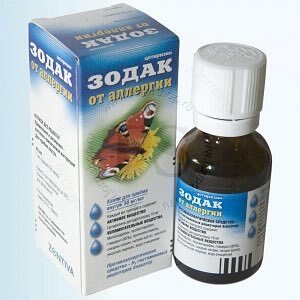 systemic preparations - eliminate itching, shortness of breath, skin irritation, nasal congestion, cough, abdominal pain. Have anti-inflammatory and immunosuppressive effect. Used intramuscularly several times a day;
systemic preparations - eliminate itching, shortness of breath, skin irritation, nasal congestion, cough, abdominal pain. Have anti-inflammatory and immunosuppressive effect. Used intramuscularly several times a day; - antihistamines - eliminate skin irritations, hoarseness, swelling, cough, shortness of breath and condition of discomfort in the abdomen. The action of the drug is aimed at slowing down the body's reactions to an allergen and accelerating deactivation. This type of medicine can be produced in the form of tablets, syrups, gels, injections;
- mast cell stabilizers - eliminate the main manifestations of allergy, the main action is aimed at increasing the level of excitability of mast cells. Produced in the form of tablets, which should be taken several times a day;
- local corticosteroids - are a powerful anti-inflammatory drug that is available in the form of tablets and gels;
- local adrenomimetiki - are aimed at eliminating the simplest symptoms( nasal congestion, cough, hoarseness).They reduce swelling and have a vasoconstrictive effect. Produced in the form of drops;
- bronchodilators - eliminate bouts of shortness of breath, are issued in the form of sprays and injections;
- antispasmodics - fight with abdominal pain and diarrhea, relax the muscles of the internal organs, reduce painful manifestations, are issued in the form of injections;
- enzyme preparations - fight with intestinal inflammations, make up the deficiency of pancreatic and intestinal enzymes. Produced in the form of tablets.
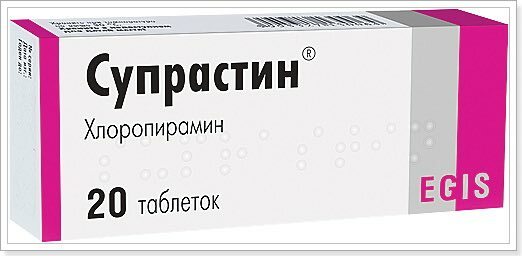
What should I do if I have an allergy?
Animal allergies very often have only one irritant factor( wool, saliva, urine).As a rule, unpleasant reactions are caused by a complex of allergens. Therefore, regular washing and shearing of pets rarely leads to a reduction in allergy attacks. The only effective way to completely eliminate the manifestation of an ailment is to part with the pet.
But even after eliminating the irritating factor, seizures may recur. This is due to the presence of wool and skin dust on furniture and other household items. Therefore, it is necessary to carry out a spring cleaning, replacing all carpets and rugs that perfectly retain allergens even after washing.
It is also recommended to ventilate the room every day several times to eliminate dust residues. Doctors also prescribe a special diet, which involves the elimination of the following ingredients from the diet:
- acute;
- is saline;
- citrus fruits;
- chocolate;
- milk;
- canned food;
- fish.
Is it possible to find a compromise and leave the pet if there is an allergy? The question is rather controversial. Neighborhood with the "bearer" of the allergen is possible only if the signs of the disease are mildly expressed and the patient does not experience serious discomfort when contacting the pet. In this case, it is necessary to regularly take a course of prevention with the help of drug therapy, as well as carry out proper care for the animal.

Prevention and measures to reduce the occurrence of allergies:
- daily wet cleaning;
- prompt response to viral and bacterial diseases;
- use of hardening procedures, which are aimed at strengthening immunity;
- filling the diet with vitamins;
- in case of having a pet in the house, it is necessary to limit his access to the bedroom and not allow him to sleep in the bed;
- use of special lamps that ionize the air;
- using a powerful vacuum cleaner with triple filter;
- use of hypoallergenic covers on furniture;
- regular hand washing to remove allergen;
- a systematic washing of the pet, while you need to wear a mask.



